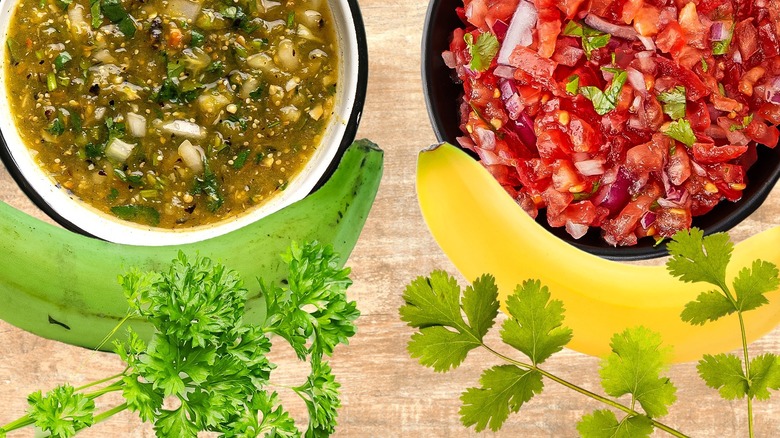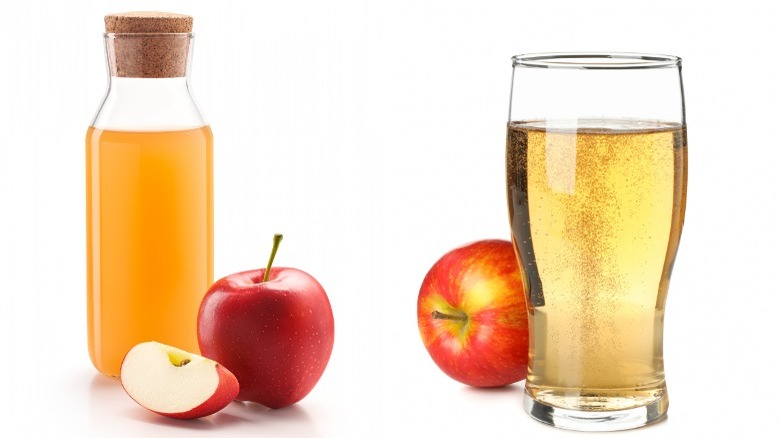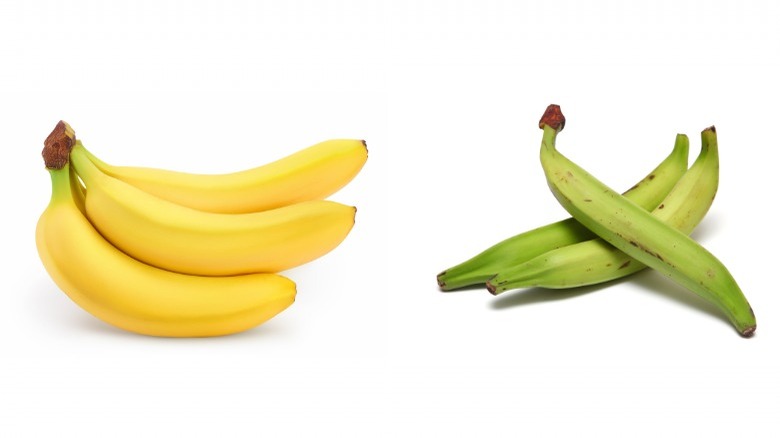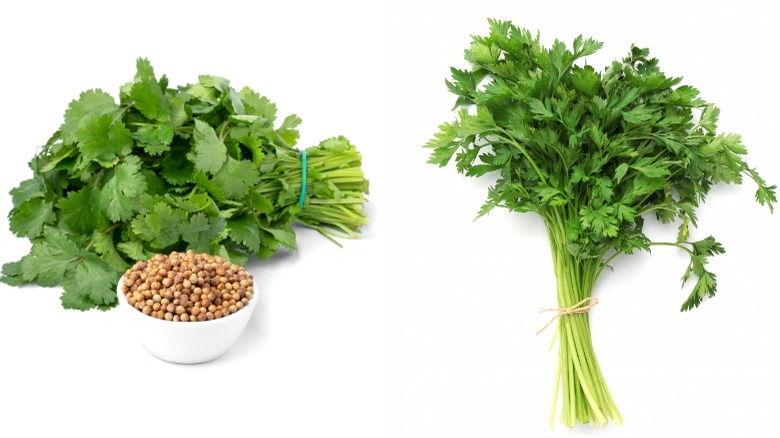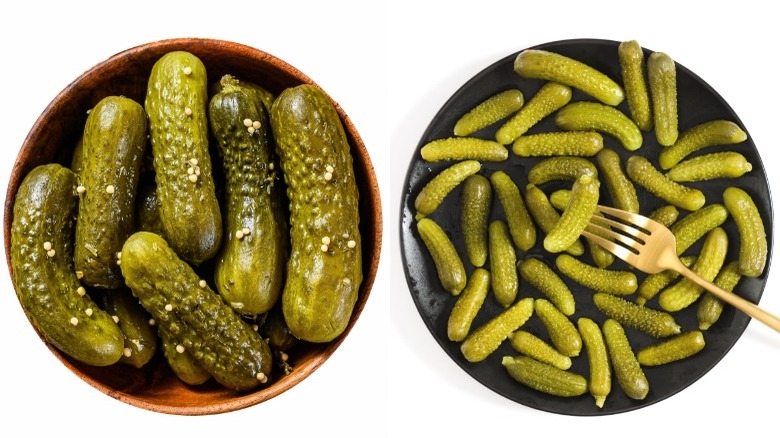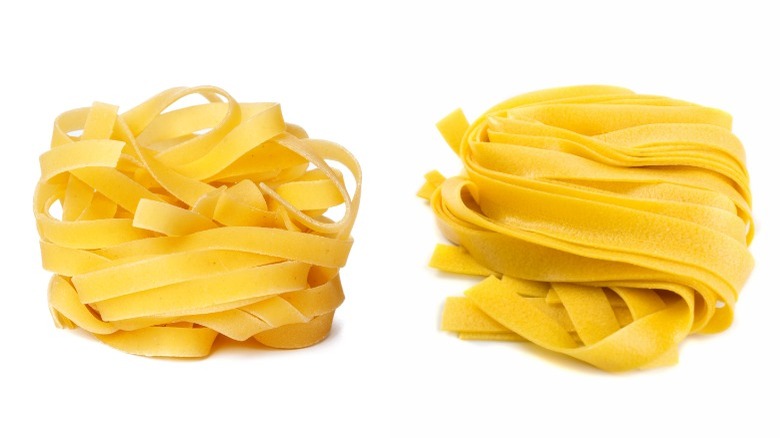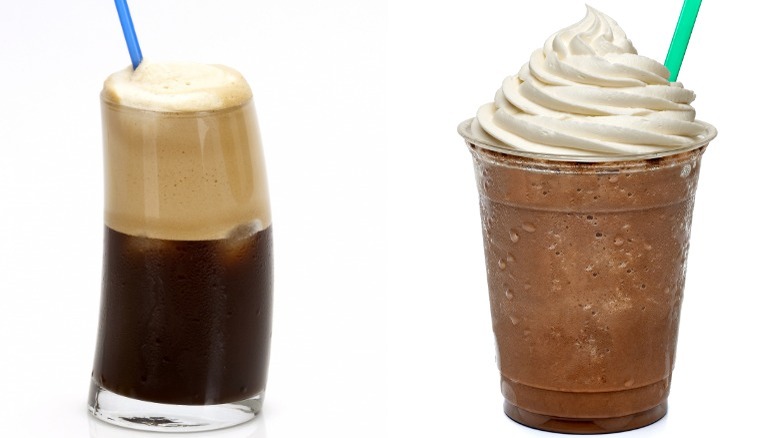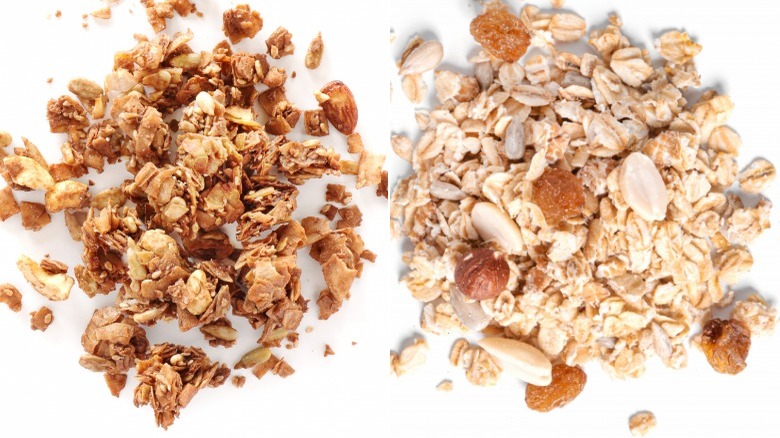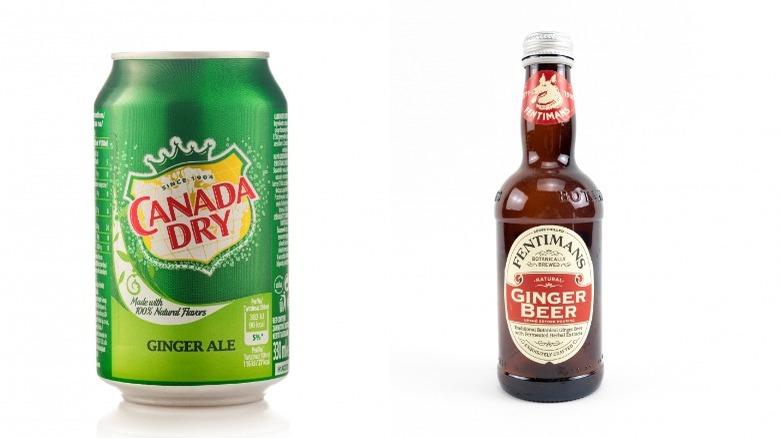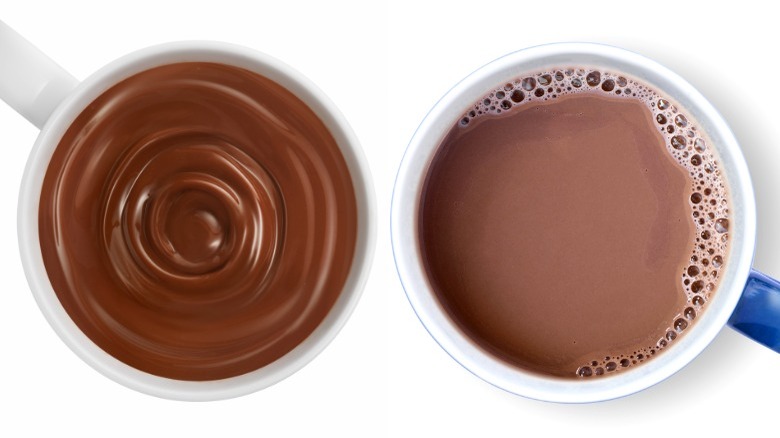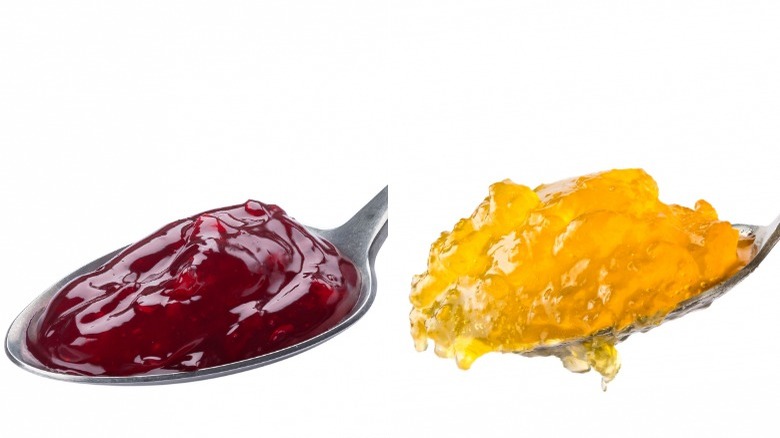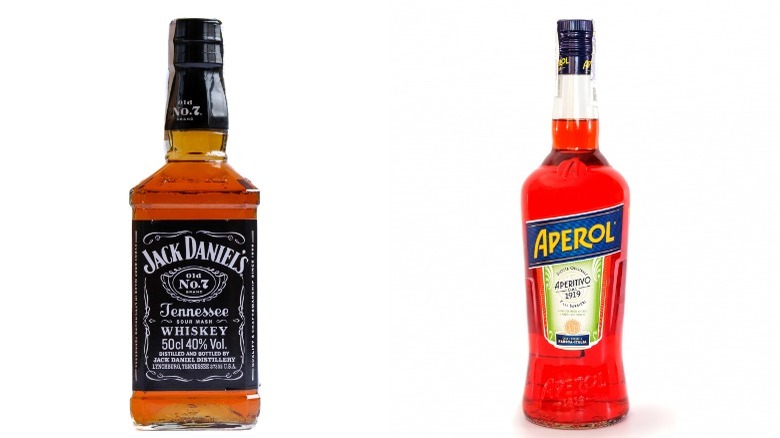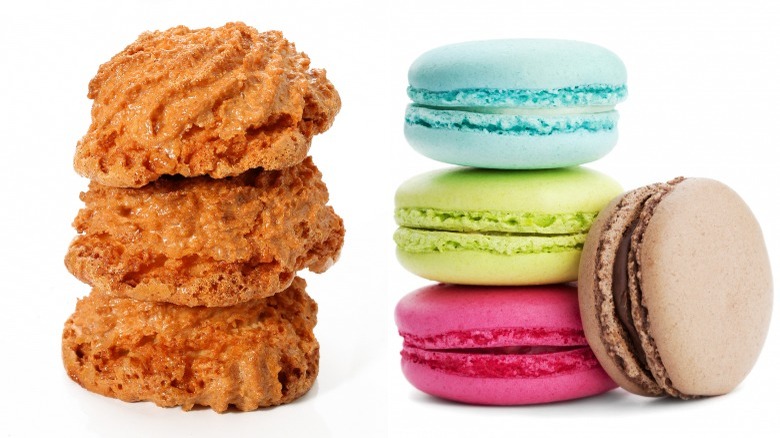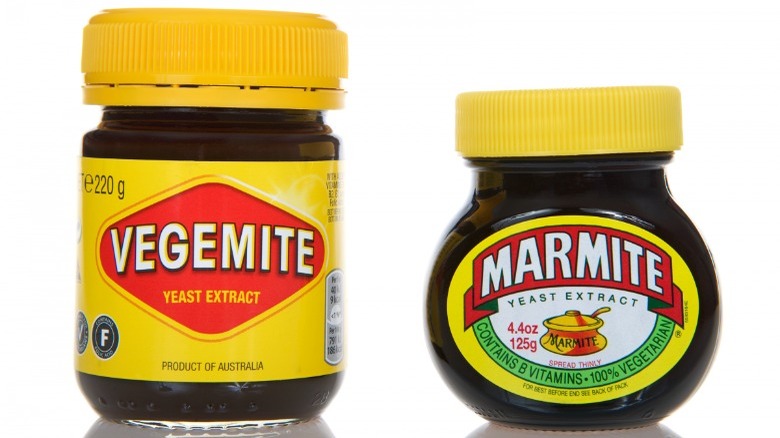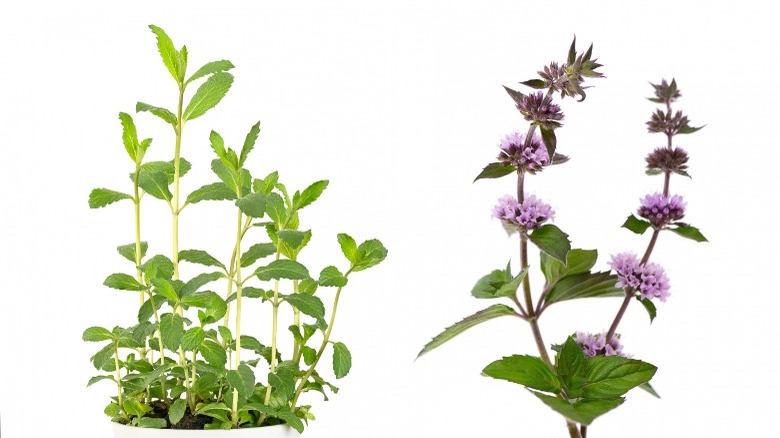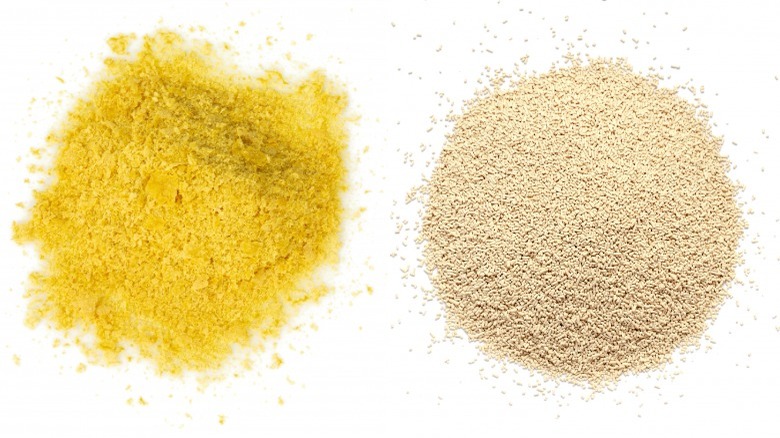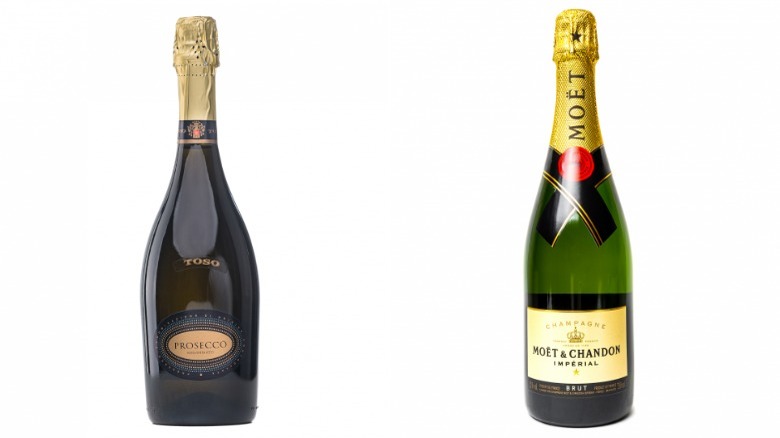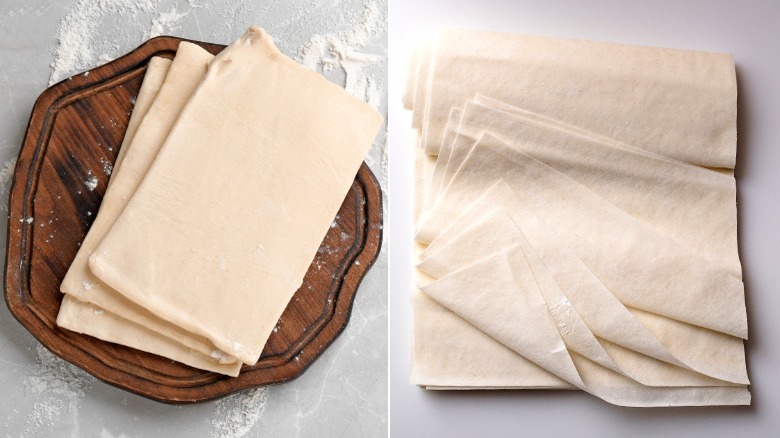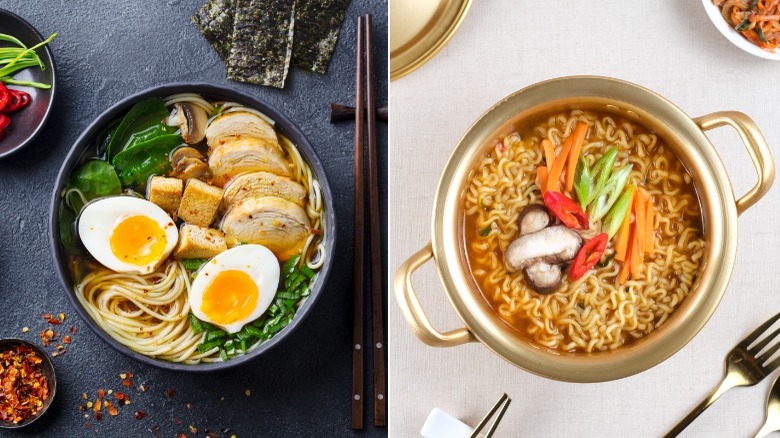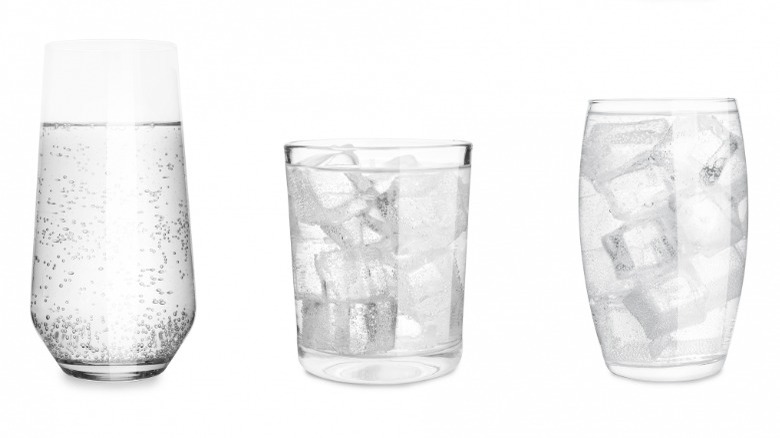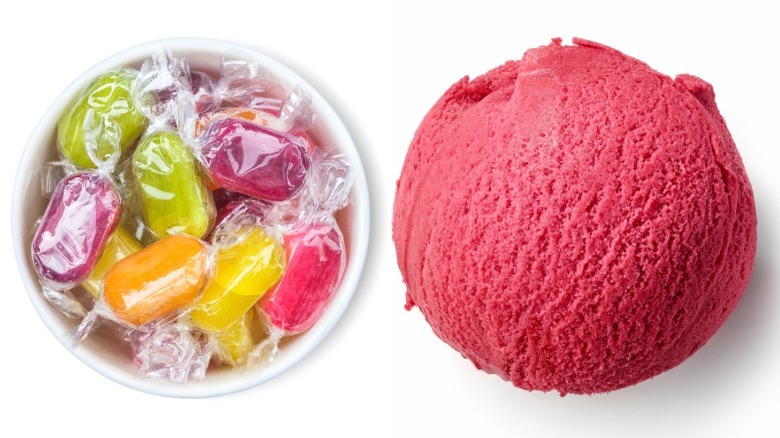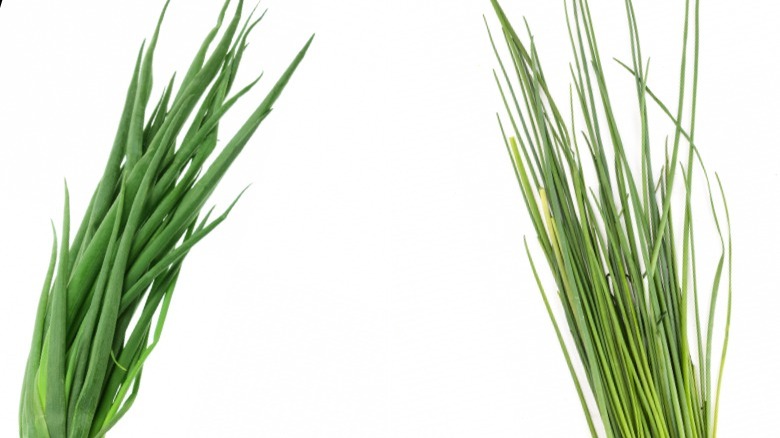22 Foods And Drinks That Get Confused With Each Other
Have you ever found yourself in the grocery store, trying to discern parsley from cilantro or scallions from chives from the pictures you hectically looked up on your phone? Or maybe you've looked at a recipe's ingredient list and wondered whether you could use apple cider instead of vinegar or puff pastry instead of phyllo dough? Perhaps you've felt embarrassed or disappointed after mistakenly ordering macaroons and hot cocoa instead of macarons and hot chocolate? We've all been there. There are countless foods and drinks that are visually, linguistically, or conceptually similar but are actually quite distinct from each other, and navigating it can be frustrating.
To help you out, we've compiled a list of these commonly confused culinary conundrums. From herbs to pastries, spreads to beverages, we'll break down the differences and help you become a pro at telling them apart. Whether you're a food enthusiast, a curious home cook, or simply someone who wants to impress their friends at the next dinner party, this enlightening guide to some of the most easily mistaken foods and drinks will have you navigating the supermarket aisles and restaurant menus with newfound confidence.
Apple cider, vinegar, and juice
They say an apple doesn't fall far from the tree; the same is true for the liquids extracted from it. However, despite all three sharing source material, you shouldn't use them interchangeably. Apple cider vinegar is made from fermented apple juice and comes in filtered and unfiltered forms. So unless you enjoy drinking unpasteurized apple vinegar for the enzymes, you should save it for baking and salad dressings.
The difference between apple cider and apple juice is just as straightforward: While both are liquids extracted from pressed apples, the cider is the raw, unpasteurized (and therefore cloudy) version of the clarified, processed juice you're used to seeing in cartons. That is, if you're in North America — everywhere else, the term apple cider is usually reserved for the fermented alcoholic drink.
Bananas and plantains
While the two share some striking similarities (including the fact that both are called plátano in Spanish), these fruits are nevertheless not the same. The first of the key differences between bananas and plantains is their appearance: The latter are usually larger and have thicker skin, making them a bit more robust. Flavor-wise, they're less sweet and have a starchy texture, which makes them perfect for cooking. You'll often find boiled, grilled, steamed, and fried plantains in various dishes, especially in Caribbean and African cuisines.
On the other hand, bananas are smaller, sweeter, and softer, which makes them ideal for snacking or adding natural sweetness to smoothies or baked goods. So next time you're at the grocery store, don't be fooled — plantains and bananas are more than just a case of mistaken identity.
Cilantro, parsley, and coriander
Depending on where you're from and your knowledge of herbs, it could be easy to confuse these. Luckily, there is an easy way to tell the difference between cilantro and coriander: technically, they're the same plant — Coriandrum sativum. However, if you're in North America, you likely use "coriander" for the dried seeds and "cilantro" for the greens. In most other places, coriander is the dominant term for both.
When it comes to telling cilantro and parsley apart, rely on your senses. First, examine the leaves and stalks: Cilantro has more delicate, less pointy leaves and often comes with roots intact. The citrusy smell of cilantro is another thing that sets it apart from the earthy, grassy parsley. And, of course, it might be even easier to tell the two apart if your genetic makeup makes cilantro smell and taste like soap.
Cornichons and gherkins
Pickled cucumbers come in all shapes and sizes. All of them, including cornichons and gherkins, fall into the general "pickle" category of brined, fermented, and preserved foods. And while you can dig deeper into the preparation methods and flavorings used for different pickle varieties, when it comes to telling the difference between gherkins and cornichons, their size is the obvious clue.
Both terms refer to small pickling cucumber cultivars, but are they the same thing? Not really. Cornichons (or French gherkins) are only allowed to grow a couple of inches before they get cured and brined, whereas gherkins can be up to 5 inches long. Additionally, tarragon-flavored cornichons are tangier, whereas dill gherkins can contain a note of sweetness. Technicalities aside, either variety will work well on a charcuterie board or as a crunchy snack.
Fettuccine, pappardelle, linguine and tagliatelle
While these types of pasta are almost indistinguishable to an untrained eye, closer inspection will highlight their differences. Linguine is a long, thin, flat eggless noodle similar to spaghetti. Its delicate texture works well with lighter sauces. You'll find pappardelle on the other side of the spectrum: at ¾-1¼ inches wide, it's the broadest of the bunch, chewy thanks to the eggs in the dough, and typically served with a thick ragù sauce.
The difference between tagliatelle and fettuccine is less drastic, though still noticeable. The former is such an important part of Bolognese culinary heritage that Bologna's Chamber of Commerce declared that authentic tagliatelle should be exactly 8 millimeters (⅓ inch) wide after cooking. Fettucine, in turn, is usually about ¼ inch wide and almost twice as thick as tagliatelle. And while all four varieties are an excellent fit for Alfredo sauce, it is most often paired with fettuccine.
Frappe and frappuccino
Beyond their similar-sounding names, these two cold coffee-based drinks could not be more different. Frappe originated at a trade fair in Greece over half a century ago, when a Nestlé worker used a shaker, cold water, and ice cubes to make his instant coffee. Frappuccino entered the scene in the early 1990s when George Howell, a New England coffee shop owner, created his version of the iced cappuccino mixed in a granita machine. A few years later, Starbucks bought him out and trademarked the drink, which became a global sensation.
Geography aside, the real difference between a frappe and a frappuccino boils down to their ingredients: the Greek concoction is made from instant coffee, sugar, and ice and is often whipped by hand, while the frappuccino is milk and syrup-heavy, uses brewed coffee as a base, and is made in a blender.
Granola and muesli
Both of these breakfast staples came out of the late 19th-century quest for healthier eating: First, Dr. James Caleb Jackson developed his "granula" graham cakes in an upstate New York sanitarium in 1863, and Dr. John Harvey Kellogg soon followed with his own version (later renamed "granola" to avoid a lawsuit from Jackson) in the late 1870s. Across the Atlantic, Dr. Maximilian Bircher-Benner developed muesli for patients of his Zurich sanitarium in the early 1900s.
But the main difference between muesli and granola lies in the production process: the former is a loose mix of raw oats with dried fruit and nuts, while the latter uses sweeteners such as maple syrup to help hold the mixture together when baked. As a result, muesli is either soaked overnight or served with milk like other cereals, while granola is used as a crunchy topping for smoothies and yogurt bowls.
Ginger ale and ginger beer
Although both contain the namesake ingredient, ginger ale and ginger beer vary in their production process and flavor intensity. Ginger beer is a fermented drink that's made with fresh ginger, sugar, water, and a starter culture (SCOBY or "ginger bug"). It has a spicy, slightly sweet flavor with a prominent ginger presence. As a result of fermentation, it is often cloudy and has a more complex flavor profile than ginger ale, which makes it a popular mixer in cocktails. It's usually sold as a soft drink, but alcoholic versions exist as well.
Ginger ale, on the other hand, doesn't involve fermentation: It's made by mixing ginger extract, sugar, and carbonated water. It has a milder flavor than ginger beer, and it's often used as a mixer in non-alcoholic cocktails or as a settler for nausea or upset stomach.
Hot chocolate and hot cocoa
At first glance, these wintertime-favorite beverages might seem closely related. However, centuries set them apart: Hot chocolate has been enjoyed in Mesoamerica for thousands of years, only making it to Europe in the late Middle Ages, where over time, it was stripped of some of the key ingredients such as hot peppers and made milder to suit European tastes. The industrial revolution made cocoa processing cheap; thus, hot cocoa was born.
There are more differences between hot cocoa and hot chocolate when it comes to the core ingredient. To make hot cocoa, you'll need cocoa powder, milk, and sugar. It's sweeter, lighter, and more straightforward in terms of flavor and texture. In turn, making hot chocolate calls for melted dark or semisweet chocolate instead (or in addition to) cocoa powder. It has a rich, creamy texture and a more indulgent, complex chocolatey flavor.
Jams, jellies, and marmalades
Telling different types of fruit preserves apart might be a challenge until you open up a jar and take a closer look at the texture. While all of them involve cooking prepped fruit down in some combination of sugar and water, the resulting delicacies bear some differences.
Jelly is the easiest to identify at first glance: it has a homogenous consistency and that irresistible clear look. It's achieved by straining the fruit pulp and cooking leftover juice down further, sometimes with the addition of pectin to help it set. Naturally, jam is made much the same way, but the fruit stays in, making it a bit chunkier but still easily spreadable. Finally, marmalades are typically a citrus preserve that's somewhere between jam and jelly in texture, thanks to the pectin-heavy citrus rinds.
Liquor and liqueur
Not only do these terms sound alike, but they are often used interchangeably as synonyms for alcohol. And while liqueur can be considered a liquor, the same can't be said in reverse. If you're perplexed, let's clarify the difference between liquor and liqueur.
Liquor is a broad term for drinks distilled from grains, fruits, or vegetables with a high alcohol content (around 40% ABV). It's the type of spirit you might have on the rocks, as a shot, or accompanied by a non-alcoholic mixer — think whiskey, vodka, gin, rum, and tequila. Liqueurs, in turn, are sweetened alcoholic beverages made by combining a distilled spirit with sugar, herbs, spices, fruit, and sometimes cream. They have a lower alcohol content (usually between 15-30% ABV), and a sweeter, more complex flavor profile. Aperol, Cointreau, and Bailey's Irish Cream are all good examples.
Macaroons and macarons
When you look at the two side by side, it's obvious that the difference between macaroons and macarons goes beyond one extra letter. Macarons are delicate sandwich cookies made from almond flour, egg whites, sugar, and various fillings. In contrast, macaroons are their low-fuss cousin. These small drop cookies are made from shredded coconut, egg whites, and sugar. They have a chewy, dense texture and are less fragile.
Despite their differences, the two have a common etymology and origin story: Their Arab ancestor — a cookie made from ground nuts and honey — traveled to Italy, where it was dubbed maccheroni, and was later brought over to France by Catherine de Medici, where modern macaron slowly took shape. Macaroons were a 19th-century American take on the dessert that involved replacing the almond flour with shredded coconut for a firmer cookie.
Marmite and Vegemite
Marmite and Vegemite are two widely popular yeast extract spreads originating in the United Kingdom and Australia, respectively. Marmite has been around since 1902, while Vegemite emerged as its alternative in 1923 when World War I disrupted imports to Australia. These spreads are famously umami-packed and are commonly used in sandwiches, stews, soups, and pasta dishes to enrich their flavor.
While the differences between the two are subtle, they are still noticeable in texture and taste. While both spreads are made from discarded brewers yeast combined with vegetable and spice extracts, Vegemite has a thicker and darker consistency, while Marmite is more syrupy. In terms of flavor, Marmite has a slightly sweet and mild taste, whereas Vegemite boasts a more robust yeasty flavor with bitter notes. Of course, you could use them interchangeably in a pinch, but you'll likely prefer one over the other.
Mint, spearmint, and peppermint
Mint is an overarching term for the Mentha plant family, so all the cultivars you're familiar with technically fall under the "mint" category. The two varieties you'll often find in restaurants and produce markets are peppermint and spearmint, which have distinct appearances, flavors, and culinary uses.
The color of the stem and leaves might help tell the two apart: peppermint often has dark green leaves and purple stems, whereas spearmint is bright green. But the real difference between spearmint and peppermint is in their flavor. Peppermint has a more potent flavor with spicy notes due to its 40% menthol content. In contrast, spearmint contains only 0.5% menthol and has a milder, sweeter flavor due to carvone, a naturally occurring chemical, making it more versatile as a garnish and ingredient in savory dishes.
Nutritional and instant dry yeast
Telling the difference between nutritional and instant dry yeast might not be an issue if you're a seasoned plant-based eater. However, if you're new to vegan cooking, you might confuse the two. Despite both ingredients having "yeast" in the title, they serve vastly different purposes.
Instant dry yeast is a live culture primarily used for baking bread and other dough-based products. It acts as a leavening agent, causing the dough to rise by fermenting the sugars and releasing carbon dioxide. In contrast, if you dare bake some cinnamon buns with nutritional yeast, they simply won't rise. That's because nutritional yeast is deactivated, meaning it doesn't have the leavening powers of baker's yeast. Instead, it's used as an umami-packed seasoning or a dietary supplement, particularly popular among vegans for its cheesy flavor and vitamin B12 content.
Pico de gallo and salsa
Pico de gallo and salsa are popular Mexican condiments that initially might seem quite similar. However, there are some key differences that set them apart. Pico de gallo is a raw, chunky mixture of diced tomatoes, onions, jalapeños, cilantro, and lime juice. It is usually made as a topping or side, and its refreshing taste complements the flavors of tacos, fajitas, and nachos.
On the other hand, salsa, which simply means "sauce" in Spanish, is a looser term. Salsa can be cooked or raw, smooth or chunky, but generally has a more liquid consistency than pico de gallo. Many salsa varieties, such as red, green, and even fruit-based, can be found in Mexico and the U.S., where it is commonly used as a dip for tortilla chips or as a sauce to enhance the flavors of main dishes.
Prosecco and Champagne
Wine purists might already know the difference between Champagne and Prosecco, but the rest of us require a brief lesson in wine appellation. What's that, you ask? It's a certification system regulating wine production and labeling that defines the geographical origin, production methods, and grape varieties that can be used, drawing the principal line between these popular sparkling wine varieties.
Champagne hails from the Champagne region in France, while Prosecco originates from the Veneto region in Italy. The primary grape used for making Champagne is Chardonnay, Pinot Noir, or Pinot Meunier, whereas Prosecco is made from the Glera grape. In terms of production, Champagne undergoes a complex process involving a second fermentation in the bottle, whereas Prosecco's second fermentation takes place in stainless steel autoclaves. This difference gives Champagne its characteristic yeasty notes, while Prosecco has a fruitier flavor.
Puff pastry and phyllo dough
While both are flaky, layered pastries typically sold in sheets, the differences between puff pastry and phyllo dough are the reason you probably should avoid making a phyllo croissant or a puff pastry baklava.
Puff pastry, a 17th-century French invention, is made by layering butter between sheets of dough, creating fat pockets. During baking, the butter melts and creates steam, causing the dough to puff up into many rich, flaky layers you know well through turnovers and pot pies. On the other hand, the paper-thin pastry known as phyllo (or filo) dates back to the 11th-century Byzantine Empire. It's made by stretching out a mixture of flour, water, vinegar, salt, and a touch of oil. Unlike puff pastry, phyllo dough doesn't contain butter between its layers, which results in a lighter and crispier texture perfect for borek or spanakopita.
Ramen and ramyeon
Though often mistaken for each other, ramen and ramyeon are actually two distinct types of noodle dishes with their own unique characteristics. While both are essentially comforting bowls of noodle goodness, the flavors, spice levels, and noodle varieties set them apart.
Hailing from Japan, ramen is a famous noodle soup featuring Chinese-style wheat noodles soaked in a rich and flavorful broth, often seasoned with soy sauce or miso. Adding toppings like seaweed, mushrooms, green onions, and bamboo shoots further enhances the ramen experience. Ramyeon is its Korean counterpart, known for its exclusive use of instant noodles and noticeable spiciness. The ramyeon broth is generally made from beef or vegetable stock, and the heat comes from spicy seasonings like gochujang (Korean chili paste) used generously. Common toppings for ramyeon include green onions, kimchi, vegetables, and rice cakes.
Seltzer, tonic, sparkling water, and club soda
If you placed unlabeled bottles of seltzer, tonic, sparkling water, and club soda next to each other, they would look indistinguishable. However, each one of these drinks is unique in its own way.
The difference between sparkling water and seltzer is in the source of their bubbles. Seltzer is artificially carbonated water with no added minerals or flavors. On the other hand, sparkling mineral water is naturally carbonated and often contains minerals that give it a distinctive taste. Club soda is somewhere between the two: its bubbles and minerals are added during production. Thanks to the addition of sodium bicarbonate and potassium sulfate, club soda often has a slightly salty taste. Lastly, tonic water is carbonated water infused with quinine, sugar, and various flavorings, making this bittersweet fizzy water an excellent cocktail mixer.
Sherbet, sorbet, and sherbert
It's not just the spelling — the ingredients in sherbet and sorbet are different too. Let's start with sorbet: Made from fruit puree, sugar, and water, it's a refreshing dessert perfect for vegans and lactose-intolerant folks. Now, sherbet (sometimes called sherbert) also contains fruit and sugar but with some dairy added for a smoother texture. This makes sherbet a delightful middle ground between sorbet and ice cream.
Interestingly, both terms are descendants of "sharba," an Arabic word for "drink." You can still find the sweet fruity drink called sharbat in Turkey, Iran, India, and surrounding countries. In contrast, British sherbet is something else entirely: It's either a powdered mix of sugar, baking soda, and tartaric acid meant to be dissolved in water or a type of candy with that same fizzy mixture in the middle.
Spring onions, scallions, and chives
Often used interchangeably in cooking, these allium family members are, nevertheless, slightly different from each other. Chives belong to a different species than the other three and are smaller and more delicate. With their slender, grass-like appearance and gentle, garlicky taste, they're a fantastic choice for adding a pop of color and a hint of savory goodness to your dishes.
Spring onions, also known as green onions in Canada and the U.K., have a small, round bulb at the base and long, green stalks. They are the most pungent of the bunch due to growing the longest before being harvested. Finally, we have scallions and green onions, essentially the same plant (Allium fistulosum). Some believe the difference in naming is purely geographical, while others insist that the two are harvested at different stages, with scallions being the younger version of green onions.
Static Media owns and operates Tasting Table and Mashed.
